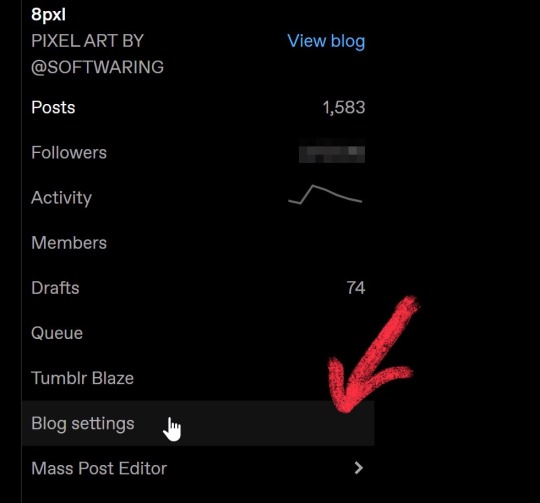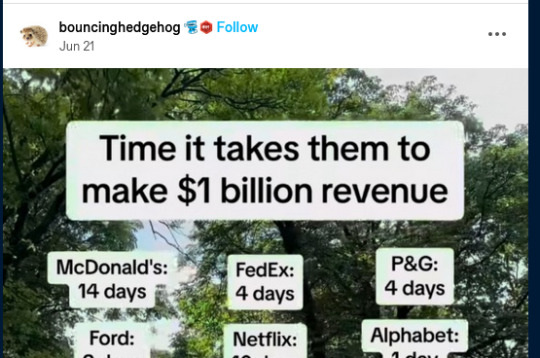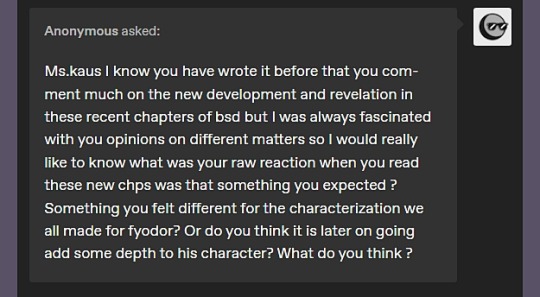#Data Profit
Explore tagged Tumblr posts
Text
PSA: Tumblr/Wordpress is preparing to start selling our user data to Midjourney and OpenAI.
you have to MANUALLY opt out of it as well.




to opt out on desktop, click your blog ➡️ blog settings ➡️ scroll til you see visibility options and it’ll be the last option to toggle.
to opt out on mobile, click your blog ➡️ scroll then click visibility ➡️ toggle opt out option.
if you’ve already opted out of showing up in google searches, it’s preselected for you. if you don’t have the option available, update your app or close your browser/refresh a few times. important to note you also have to opt out for each blog you own separately, so if you’d like to prevent AI scraping your blog i’d really recommend taking the time to opt out. (source)
#ai#tumblr ai#midjourney#openai#protect your creative efforts and don’t let them profit off your work!!#fuck tumblr they specifically said months ago they’d NEVER sell user data yet here we are#AND after the ceo has been harassing trans users like wtf is this fucking site becoming#tumblr news#tumblr#tumblr update#anti ai#support human artists
34K notes
·
View notes
Text
Charting Progress: Visualizing Business Advancements Through Comprehensive Analytics
In the realm of modern business, progress is intricately tied to data-driven insights. This blog takes you on a journey through the world of comprehensive analytics, where business advancements are quantified and visualized. Join us as we explore the art of turning data into dynamic visuals that tell the story of growth and success.
Read Full Blog Here: https://www.anervea.com/charting-progress-visualizing-business-advancements-through-comprehensive-analytics
Comprehensive Analytics: Unveiling Business Realities
Data is the heartbeat of every successful business, but raw data alone can be overwhelming. Comprehensive analytics transforms data into clear, actionable insights that drive strategic decisions. It's the process of extracting meaning from the numbers and turning it into a powerful narrative of business performance.
Visualizing the Journey: Transforming Data into Visual Insights
Numbers on a spreadsheet come to life when they're transformed into visual representations. Visualizations, like charts, graphs, and interactive dashboards, make complex data accessible, providing a visual snapshot of key performance indicators, trends, and growth patterns.
Advantages of Visual Analytics
Visual analytics offer a multitude of advantages. They provide a quick, intuitive way to grasp complex information, making it easier for decision-makers at all levels to understand the bigger picture. Visualizations enable faster identification of trends, outliers, and correlations, ultimately leading to informed decisions that drive business progress.
Quantifying Success: Measuring Growth Metrics
Comprehensive analytics empowers businesses to measure their progress and success with precision. Whether it's revenue growth, customer acquisition, or market expansion, data-driven metrics are quantified and visualized. This not only highlights achievements but also pinpoints areas that need attention.
Performance Tracking: Real-Time Insights
Business landscapes are ever-changing, and tracking performance in real time is essential for staying agile. Visual dashboards provide real-time insights into key metrics, allowing businesses to make informed adjustments and capitalize on emerging opportunities.
Identifying Patterns and Trends: The Crystal Ball of Business
Patterns and trends in data often hold the key to strategic decisions. Comprehensive analytics unveil these patterns through visualizations, empowering businesses to anticipate market shifts, customer preferences, and emerging opportunities. This predictive aspect is akin to having a crystal ball that guides decision-making.
Engaging Stakeholders: From Data to Decision-Making
Visualizations bridge the gap between data and decision-making. When presenting insights to stakeholders, visual analytics are a powerful tool. They engage the audience, simplify complex information, and convey insights with impact. From boardroom presentations to marketing strategies, visualizations are the language that speaks to all.
The Power of Storytelling Through Data
Consider a scenario where a retail business employs comprehensive analytics to measure the success of a marketing campaign. They can track metrics through visualizations, like website traffic, click-through rates, and conversion rates. Visual dashboards highlight the campaign's effectiveness in real time, allowing the marketing team to make immediate adjustments and capitalize on its success.
Conclusion: Transforming Data into Success Narratives
Comprehensive analytics transforms data from an abstract concept into a tangible success narrative. Through visualizations, businesses can chart their progress, identify growth opportunities, and make informed decisions that drive advancement. In the ever-evolving business landscape, the art of turning data into visual insights is the key to staying competitive and thriving.
Visit our website now: https://www.anervea.com/

#healthcare#data analytics#pharmasales#pharmaceutical industry#Data Monetization#businessgrowth#Data Profit#Maximize Analytics#marketing
0 notes
Text




step 1: develop hyperfixation on coding with R
step 2: ??!!??!? (for three weeks straight)
step 3: fully interactive LCARS inspired website that does CGM analysis for the minuscule audience of diabetic star trek nerds
#step 4 no profit i do this for the love of the game#it’s still a work in progress#im steadily losing my anonymity on here but whatever#lcars#star trek#star trek tng#R#rstudio#programming#diabetes#cgm#dexcom#data analysis
210 notes
·
View notes
Text
communist generative ai boosters on this website truly like

#generative ai#yes the cheating through school arguments can skew into personal chastisement instead of criticising the for-profit education system#that's hostile to learning in the first place#and yes the copyright defense is self-defeating and goofy#yes yeeeeeeeeeees i get it but fucking hell now the concept of art is bourgeois lmaao contrarian ass reactionary bullshit#whYYYYYYY are you fighting the alienation war on the side of alienation????#fucking unhinged cold-stream marxism really is just like -- what the fuck are you even fighting for? what even is the point of you?#sorry idk i just think that something that is actively and exponentially heightening capitalist alienation#while calcifying hyper-extractive private infrastructure to capture all energy production as we continue descending into climate chaos#and locking skills that our fucking species has cultivated through centuries of communicative learning behind an algorithmic black box#and doing it on the back of hyperexploitation of labour primarily in the neocolonial world#to try and sort and categorise the human experience into privately owned and traded bits of data capital#explicitly being used to streamline systematic emiseration and further erode human communal connection#OH I DON'T KNOW seems kind of bad!#seems kind of antithetical to and violent against the working class and our class struggle?#seems like everything - including technology - has a class character and isn't just neutral tools we can bend to our benefit#it is literally an exploitation; extraction; and alienation machine - idk maybe that isn't gonna aid the struggle#and flourishing of the full panoply of human experience that - i fucking hope - we're fighting for???#for the fullness of human creative liberation that can only come through the first step of socialist revolution???#that's what i'm fighting for anyway - idk what the fuck some of you are doing#fucking brittle economic marxists genuinely defending a technology that is demonstrably violent to the sources of all value:#the soil and the worker#but sure it'll be fine - abundance babey!#WHEW.
9 notes
·
View notes
Text

again its difficult being the only correct person on the internet but this drives me crazy. like surely we understand that a companys GROSS INCOME is going to be higher than minimum wage. because large portions of that are going to pay for literally every other aspect of business like buying product and hiring people and so on and so forth. like "1 billion revenue" sounds like a lot until you remember the expenses are .99 billion.
#like obviously there are problems w the distibution of profit#but making it using this data is nothing mama its bones#its meaningless
21 notes
·
View notes
Text
[T]he Dutch Republic, like its successor the Kingdom of the Netherlands, [...] throughout the early modern period had an advanced maritime [trading, exports] and (financial) service [banking, insurance] sector. Moreover, Dutch involvement in Atlantic slavery stretched over two and a half centuries. [...] Carefully estimating the scope of all the activities involved in moving, processing and retailing the goods derived from the forced labour performed by the enslaved in the Atlantic world [...] [shows] more clearly in what ways the gains from slavery percolated through the Dutch economy. [...] [This web] connected them [...] to the enslaved in Suriname and other Dutch colonies, as well as in non-Dutch colonies such as Saint Domingue [Haiti], which was one of the main suppliers of slave-produced goods to the Dutch economy until the enslaved revolted in 1791 and brought an end to the trade. [...] A significant part of the eighteenth-century Dutch elite was actively engaged in financing, insuring, organising and enabling the slave system, and drew much wealth from it. [...] [A] staggering 19% (expressed in value) of the Dutch Republic's trade in 1770 consisted of Atlantic slave-produced goods such as sugar, coffee, or indigo [...].
---
One point that deserves considerable emphasis is that [this slave-based Dutch wealth] [...] did not just depend on the increasing output of the Dutch Atlantic slave colonies. By 1770, the Dutch imported over fl.8 million worth of sugar and coffee from French ports. [...] [T]hese [...] routes successfully linked the Dutch trade sector to the massive expansion of slavery in Saint Domingue [the French colony of Haiti], which continued until the early 1790s when the revolution of the enslaved on the French part of that island ended slavery.
Before that time, Dutch sugar mills processed tens of millions of pounds of sugar from the French Caribbean, which were then exported over the Rhine and through the Sound to the German and Eastern European ‘slavery hinterlands’.
---
Coffee and indigo flowed through the Dutch Republic via the same trans-imperial routes, while the Dutch also imported tobacco produced by slaves in the British colonies, [and] gold and tobacco produced [by slaves] in Brazil [...]. The value of all the different components of slave-based trade combined amounted to a sum of fl.57.3 million, more than 23% of all the Dutch trade in 1770. [...] However, trade statistics alone cannot answer the question about the weight of this sector within the economy. [...] 1770 was a peak year for the issuing of new plantation loans [...] [T]he main processing industry that was fully based on slave-produced goods was the Holland-based sugar industry [...]. It has been estimated that in 1770 Amsterdam alone housed 110 refineries, out of a total of 150 refineries in the province of Holland. These processed approximately 50 million pounds of raw sugar per year, employing over 4,000 workers. [...] [I]n the four decades from 1738 to 1779, the slave-based contribution to GDP alone grew by fl.20.5 million, thus contributing almost 40% of all growth generated in the economy of Holland in this period. [...]
---
These [slave-based Dutch commodity] chains ran from [the plantation itself, through maritime trade, through commodity processing sites like sugar refineries, through export of these goods] [...] and from there to European metropoles and hinterlands that in the eighteenth century became mass consumers of slave-produced goods such as sugar and coffee. These chains tied the Dutch economy to slave-based production in Suriname and other Dutch colonies, but also to the plantation complexes of other European powers, most crucially the French in Saint Domingue, as the Dutch became major importers and processers of French coffee and sugar that they then redistributed to Northern and Central Europe. [...]
The explosive growth of production on slave plantations in the Dutch Guianas, combined with the international boom in coffee and sugar consumption, ensured that consistently high proportions (19% in 1770) of commodities entering and exiting Dutch harbors were produced on Atlantic slave plantations. [...] The Dutch economy profited from this Atlantic boom both as direct supplier of slave-produced goods [from slave plantations in the Dutch Guianas, from Dutch processing of sugar from slave plantations in French Haiti] and as intermediary [physically exporting sugar and coffee] between the Atlantic slave complexes of other European powers and the Northern and Central European hinterland.
---
Text above by: Pepijn Brandon and Ulbe Bosma. "Slavery and the Dutch economy, 1750-1800". Slavery & Abolition Volume 42 (2021), Issue 1. Published online 28 February 2021. DOI at: doi dot org slash 10.1080/01440396 . 2021. 1860464 [Text within brackets added by me for clarity and context. Bold emphasis and some paragraph breaks/contractions added by me. Presented here for commentary, teaching, criticism.]
#abolition#these authors lead by pointing out there is general lack of discussion on which metrics or data to use to demonstrate#extent of slaverys contribution to dutch metropolitan wealth when compared to extensive research#on how british slavery profits established infrastructure textiles banking and industrialisation at home domestically in england#so that rather than only considering direct blatant dutch slavery in guiana caribbean etc must also look at metropolitan business in europe#in this same issue another similar article looks at specifically dutch exporting of slave based coffee#and the previously unheralded importance of the dutch export businesses to establishing coffee mass consumption in europe#via shipment to germany#which ties the expansion of french haiti slavery to dutch businesses acting as intermediary by popularizing coffee in europe#which invokes the concept mentioned here as slavery hinterlands#and this just atlantic lets not forget dutch wealth from east india company and cinnamon and srilanka etc#and then in following decades the immense dutch wealth and power in java#tidalectics#caribbean#archipelagic thinking#carceral geography#ecologies#intimacies of four continents#indigenous#sacrifice zones#slavery hinterlands#european coffee#indigenous pedagogies#black methodologies
50 notes
·
View notes
Text
you know what idgaf personally if firefox is selling my data i'm not moving browsers again. whatever
#vero.txt#t#everyone and their grandmother is selling my data being on the internet should not be this difficult#its unsurprising that they became a sellout im sure it wasnt profitable to avoid selling data
8 notes
·
View notes
Text
you know i think it's really funny (derogatory) that tumblr seemingly has the ability to create popups for ad-free, crabs, anything that will get them money, but when it comes to using popups to guide new users around the website layout they're just like "uww what can we POSSIBLY do?? all these new people only know twitter and they couldn't possibly read a popup explaining how to use the site!! let's just change everything visually appealing about tumblr to cater to our inability to make popups for helpful reasons uwu!!".
like you know what i want? If you're testing a change on me I want a pop up that says so. I don't want to have to rely on the @changes blog to see that. If i'm testing a change I should be given a feedback form that is specifically about that change. I want the results of the feedback forms for changes to be publicly viewable to the userbase. you could learn so much about how this website actually functions for users through that, but no. we can only make popups when it fiscally benefits us! we can't use polls to get a sense of what the userbase is feeling! we can't publicize what % of feedback about a change was positive or negative. we couldn't...possibly...
#not dogs#tumblr#getting real sick of this shit#if you can make a pop up for ad free you can make a pop up explaining how to use this site#without changing what makes the site function and be visually appealing to those that have been here for a decade plus#look i understand tumblr is struggling to survive in this capitalist hellscape#but literally so is every other social media with the exception of those that#scrape people for their data#so you have a choice. you can be ethical or you can be profitable#which is unfortunate.#but maybe you'd be closer to profitable if you took your users seriously.
112 notes
·
View notes
Text
I want some use of my phone that is not either of
a: a vehicle for advertisement
b: any social media app that incentivizes you to keep scrolling forever and also a vehicle for advertisement (see point a)
I hate that the first thing my dysregulated brain wants to do to fill the void is to just sit and consume until I feel so numb that I get sick of it
I hate that the model for the vast majority of phone apps to is scrape for data and advertise to you. what a horrible way to live. I miss the early smart device days when it all felt new and fresh. now everyone wants to sell your personal data or sell u something
#renapup barks#yapping abt tech#it really feels like both the modern internet and smartphone ecosystems both went in the worse way possible#and that is to make as much money as possible all the time#every interaction untracked#every advert that is actually *not* obstructive#is just seen as a missed opportunity#more profit to be extracted#more clicks that could have been had#buy buy buy spend look here all of the time#keep scrolling#maybe we'll get them to buy somethimg eventually and if not well we have all this personal data to sell#we are so doomed
4 notes
·
View notes
Text

3 notes
·
View notes
Text
Ruminating a lot on intellectual property and copyright and piracy because
Even though I do fundamentally see that these things are not about allowing people to have control over their creations i also really do not sit right with the backswing opinion that therefore 'infringing' on these is harmless, actively positive, or morally correct
See. On one hand yes you should not be able to own a style. But also its very hypocritical to hold that opinion and also agree that indigenous art is not for you to take and use.
The idea that you cant steal something intangible is simply not true if you agree with that.
Is AI art (and it is art) therefore theft? This is also a hypocritical opinion. If something being trained on people's art without their permission means it is a thief, then all artists are thieves (true)
Ultimately I do not think most people truly see art as anything more than a commodity. People like to nod and agree that it is wrong to replicate indigenous art if that culture expressly makes it known this is wrong, but then roll their eyes at the concepts of closed species or people being upset at their creations being pirated.
See, the issue is not copyright or property even. It is partially an issue of consent but I think no one actually thinks of what people make as a sacred immutable aspect of themselves.
Is a species closed because the creator wants to profit off it or because it is important to them and they dont want literal aspects of their being stripped down and played with like a dress-up doll?
Is someone complaining about their game being pirated because they arent making as much money off of it as they theoretically could, or because something important to them is being stripped from them and treated as a product separate from themselves?
I'm not saying piracy is wrong or that copyright is a theoretical good thing being misused.
I just wish either stance actually saw art as sacred, rather than either a product thats purpose is to be profitted on, or as infinitely replicable (or to be made replicable) commodity to be distributed freely in protest of the former.
You are still treating the act of creation as a product separate from a creator. That it belongs to you, that you are entitled to it, that the ultimate desire of an artist is the propagation of their work and therefore the only reason they could not want their work shared is out of greed, and therefore going against their wishes is always a moral good.
You have to reckon with the idea that not all art is for you, yes. But also that art can be part of someone, and that if you use it, divorce it from that person, that they aren't going to like you. And it's not because they're greedy or want money, or believe they 'own' what they make, that it is their property.
You are just... going against someones wishes. You *are* being an asshole. Even if you feel you are in the right.
#nuance: obviously not everything someone makes is sacred to them#otherwise i would never post anything#i am not saying pirating nintendo games is bad because its sacred. it is an industry. the point is profit.#if people didnt profit off or benefit off ai art (that uses their work without their permission) it would still be unethical#maybe its the autism. but i hate the idea an object or data has no worth because it is not alive#and because it is not alive it is not part of a living thing#i dont even fully agree with my own stance here. but i know this attitude literally has killed me before (literally)#someday i will maybe elaborate on that. i dont think anyone is to blame but. i cannot ignore that it happened
2 notes
·
View notes
Text

suck my dick and balls you stupid fucking useless cunt
#the most insulting thing ive ever read and i am trans on the internet#“pay me to respect your privacy” okay bitch how about you pay me to not fucking kill your ass#i miss when websites were still going for plausible deniability on the “we don't profit off your data we swear” front#bitter posting
5 notes
·
View notes
Text
You know what I hate?
Cavern Crashers.
But you know what I hate more than that?
AI.
#fuck cavern crashers#httyd#fuck ai art#fuck ai everything#tumblr stop letting corporations scrape our data for ai and profit and shit#slimier behaviour than cavern crashers fr
19 notes
·
View notes
Text
profits over people — the corporate hellscape of internet censorship, safety, privacy, data mining…
#capitalism#internet censorship#internet#data mining#profit over people#apple#microsoft#kosa#chrome#google#privacy#privacy protection#internet privacy#monopoly#european union#eu#corporate hellscape#kids online safety act#2024
11 notes
·
View notes
Text
#spilled thoughts#writers on tumblr#poetry#spilled writing#poets on tumblr#spilled ink#creative writing#poem#artists on tumblr#singal boost#please boost#writers beware#DO NOT BUY THIS APP!#Steals data from writers#profits of them#ao3#Ao3 is just fine#please reblog
2 notes
·
View notes
Text


Greetings, Anon! Thank you for your questions. I have to admit, even in the past, I refrained from posting reactions or speculations as BSD chapters release, but you already knew that, so I will indulge you. I'll answer each part of your ask. BSD ch113 thoughts below, manga spoilers ahead.
♠ "What was your raw reaction?" It was not a calm, quiet one, I can tell you that. No, in fact I screamed with excitement as if I was in a Roman amphitheatre and my favourite gladiator just got back up on his feet, out of sheer force of will, grinning and sweaty. My scream was the fastest way I could "verbalize" the fact that I was overjoyed to see him alive again, even if it's in the 15th century, and on top of that he seemed to be some kind of spy monk all chained up and having what seems to be a ridiculous amount of fun getting caught and discussing with Bram. This is all very in-character for him.
♠ "Was that something you expected?" Absolutely not. Yes, yes, I truly did not expect a jump back in time and this infobomb drop, despite the fact that we did get a few hints that Fedya seemed present at past events when all the other character really appeared younger than him (near the end of S4ep3, where on a rooftop Fedya says "It's not V, it's Five" and I am seriously like bruh I give up what I want to say is I need more data to work with, what am I supposed to do with this, rationally speaking?). However, we can't yet extract anything conclusive from this. Is he ageless? A time-traveler? Immortal? Does he revive? When was he born? Was he born at all or created differently somehow? Is he of BSD's world, or an external one (Beast liveaction finale anyone?)? Is this all within the Book and he's just… idk flipping the pages? Anything is possible and I refuse to spend a lot of time working with incomplete data. This is not very follower-friendly (as in, my blog is basically inactive in-between), I know and I apologize, but if after many chapters there will be something worthwile to add to my essay (with what Fukuchi said in ch113 I already have important stuff to add), under those circumstances I will consider writing an update. It's not yet time.
♠ "<Was that> something you felt different for the characterization we all made for Fyodor?" Hmm, I would hesitate to refer to a characterization "we all made" for him (I wish! T o T), because my analysis and blog are but a tiny tiny part of the fandom (I think…? I wonder about my Fedya essay's reach or influence sometimes). But let's say here we refer to one that comes close to what I tried to show in my essay. In that case, I would say that there is nothing to fear here in this chapter, but it's very understandable to have massive trust issues at this point. We went through a miserable, miserable time when the previous ones made the guy who visually memorized a full deck of used cards somehow not notice Chuuya wearing contacts and fake vampire teeth, despite knowing the vampire race since… well, the 15th century! I cannot even begin to describe what I felt reading ch111.5-112, I was beyond repulsed. Lovers of "villain" characters understand the following thing well: in most media, our fav has to lose, he has to die or disappear at some point, with rare exceptions. I, too, know this well, but that was no compelling way to solve BSD's villain threat. I still don't know how BSD will wash away that narrative stain, as I consider it, but then again one of the reasons we love this manga is that it keeps us on the edge of our seats and the most absurd yet fun turns can happen out of the blue. We can reasonably ask ourselves: ok, what is the purpose of showing Fedya's backstory now? If it's for build-up, we can already start grinning like Cheshire cats. What could possibly be next? I'm cautiously optimistic, things look in-character and good to me. Very good, in fact.
♠ "Or do you think it is later on going add some depth to his character?" Backstories are shown usually for a very clear purpose. We don't know the purpose yet, but if it's done well, then… then my whole essay could be at risk lmao (and I love this sensation). New info could add so much depth to his character, in fact, that his previously observed traits could gain new meanings, or even contradictory ones. Whichever it will be, I think it's pretty safe to bet on "his backstory will be very relevant".
♠ Bonus: even if I enjoy going "full analytical" and enter conference speech mode when asked, I am driven by strong emotions, by which I want to say – I am not immune to assassin/spy monk Fedya chained up like that and having the time of his life again. I missed seeing him entertained like that, and his current …………. visual representation in the.. uh. ..chapter, yeah, well, it's doing things to my Depeche Mode-worshipping heart.
Anyway, to conclude with some facts we know as of now:
a. Fedya and Bram are inside the Bran Castle, close to the Romanian city of Brașov, "deep in the Carpathians" although not built at high altitude itself. It's basically a fortress built between 1377-1388, with several later additions. The BSD representation of it is very accurate to how it looks today. It's near perfect, actually, I applaud.
b. Bram mentions King Matthias, and in this context that can only mean Matthias Corvinus, King of Hungary for 1458-1490. The meeting between Fedya and Bram thus happens some year during his reign, when Transylvania was still part of the Kingdom of Hungary. What is still strange to me is that I can't pinpoint Bram's exact position, as in… were his people independent? Or avoided? I feel like I need to re-read past Bram-related chapters to think about this.
c. Nevermind Bram, the things that Fukuchi says, those are the real goldmine here, but the gold is still… encrypted? I mean: Fedya made the DoA plan (more than confirmed now), and because Fukuchi asked for the condition to keep casualties under 500, Fedya respected that and we got entertained for like half of the whole BSD manga: using coin bombs for terror, for economic/political destabilization, using the vampire infection to avoid further violence, these things. The more you think about it, the more insane it gets. Since Fedya agreed to this condition, it means causing (more) deaths and violence were expendable things to him. (But imagine this: Fukuchi said "I want max. 500 deaths" and Fedya said "Yeah I can do that", now if Fukuchi would've said "I want max. 2 deaths" I really believe Fedya would've still said "Yeah I can do that". What can't he do, especially since murder for murder's sake isn't his goal?). This is in perfect harmony with his "necessary deaths only" approach so far, and much much more. There are far more implications in what Fukuchi said, which I won't type out here now. Gotta keep them and build around them for a future analysis update.
This was a rather long read, but still, I hope this satisfies your curiosities, Anon. *bows dramatically & disappears in a borderline insufferable ENTP way*
#Lav answers#I can't believe I wrote so much#yet still I will keep true to my principle of not over-speculating with insufficient data#a proper essay update would be much more valuable than making separate monthly posts even though in this way I can't contribute to the hype#or despair#or both#but fans of patient analysis will profit .. richly from this#someday!#sigh why is it I can talk about Fedya for hours#why can't I..... ugh.......#Iiiiiiii caaaaan't stooooop lovinggg youuuu#OTL................#man I've chosen the best manga character of all time frfr#also as of ch113 my Philosopher!Fedya fanfic is basically.................canon-friendly to the highest degree and I can't believe it#it happens in like the 1440-1450s and I dont even know how to feel about this reveal skjdfng
13 notes
·
View notes